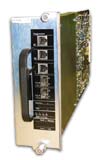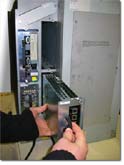|
|
| |
Quad Interface Processor (QIP)
 When dealing with multiple storage vendors you have to deal with hidden costs, points of failure and frustration to take advantage of Fibre Channel, Gigabit Ethernet and SCSI connectivity for a tape library.
When dealing with multiple storage vendors you have to deal with hidden costs, points of failure and frustration to take advantage of Fibre Channel, Gigabit Ethernet and SCSI connectivity for a tape library.
The Quad Interface Processor (QIP) technology makes it easy for you to achieve affordable connectivity for your library with flexible interface and networking options. QIPs are available on our enterprise-class libraries: 12K, 20K, 64K, T950, and T120.
QIPs Make It Easy to Achieve:
Investment Protection
Our tape libraries are available with a complete set of interface options to support SCSI, Fibre Channel and IP SAN environments. The QIP interface eliminates dependencies on third party bridge manufacturers, thus making it easy for customers to save money. QIPs extend the life of libraries by allowing them to upgrade and adapt to advancing interface technologies, while utilizing the existing library.
Data Consolidation
QIP technology makes library partitioning easy with the Shared Library Services (SLS). One QIP can manage up to four tape drives each and can turn one physical library into as many as 120 virtual libraries, thus making it easy to simultaneously utilize new and legacy operating systems, storage management software, connectivity and tape drives. Now, you can receive the benefits of true data consolidation and sharing with more than one department, application or office location.
SAN, NAS, DAS Connectivity
You can incorporate SCSI, Fibre Channel and Gigabit Ethernet connectivity in one library. Each QIP can manage up to four tape drives and support two network or SCSI connections. Our libraries can hold from one to eight QIPs, thus delivering flexible connectivity options to fit ever-changing storage environments. QIPs also make it easy for the libraries to enable iSCSI, NDMP and Serverless Backup.
Library Uptime
 QIPs are hot pluggable so that you can quickly manage library upkeep. The interface cards are also fully redundant, so that if one interface port fails, the second interface port can handle communications to all four drives.
QIPs are hot pluggable so that you can quickly manage library upkeep. The interface cards are also fully redundant, so that if one interface port fails, the second interface port can handle communications to all four drives.
|
|
|
|
|